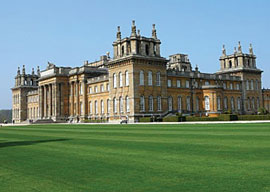
May 07, 2014

Blenheim Palace
Like many pundits opining upon French economist Thomas Piketty’s new book about how the rich always get richer and something has to be done about it, Capital in the Twenty-First Century, I haven”t actually read it.
But that’s not my fault: I blame capitalism! The capitalist system didn”t print up enough copies, and since nobody in the publishing industry seems to have ever heard of adjusting prices to balance supply and demand, the book has been on back order at Amazon and at my local Barnes & Noble.
Everybody wants to talk about income inequality, but I”m more interested in standard of living. That, of course, has two components: how much I can make, and how much I have to spend.
Something I haven”t seen mentioned in all the discussion of Piketty: Near whom would you rather live, the rich or the poor?
I”ve spent much of my life in narrow middle-class corridors between them. For example, if I stand on my front porch and crane my neck, far to the south I can make out a 17-bedroom house clinging to a Hollywood Hills cliff that was built by Goldie Hawn and Kurt Russell (and then almost immediately abandoned by them when the 1994 Northridge earthquake scared them into moving back to Malibu). A similar distance to the north of me are the dreary apartment complexes of North Hollywood and Sun Valley.
So, I”ve known rich and I”ve known poor, and when it comes to neighbors, I have to say, the rich have been cheaper for me. The children of movie stars don”t flood the local public schools, inducing me to ante up for private school tuition; they don”t spray graffiti on my street; and they don”t pack into emergency rooms for “free” medical care that gets added to my bill.
The rich don”t even take up all that much space these days. Nobody who wasn”t movie star-rich could afford to build on that mountainside, but the poor take up vast expanses of good flat land in Southern California. (The chief problem with being poor today is not that you can”t buy enough stuff, but that you can”t get away from other poor people.)
Now, all this would be very different if today’s rich dwelled not in 17-bedroom houses, but in 170-bedroom houses on multiple square miles of landscaped gardens, as did 18th-century English aristocrats.
For example, Winston Churchill was born in 1874 in Blenheim Palace, the 300,000-square-foot monument that John and Sarah Churchill, the first Duke and Duchess of Marlborough, erected to themselves in Oxfordshire in the early 1700s. Blenheim’s ponderous baroque architecture has often been criticized, but the grounds designed by landscape architect Capability Brown are indisputably sublime.
Now, that’s inequality.
According to Piketty, the rich automatically get richer because, you see, r is greater than g. So inevitably we”ll be back to the world of Jane Austen, where poor Elizabeth Bennett can only get rich by marrying Mr. Darcy.
Extravagances like the stately homes of England made economic sense before the 19th century because the relative wages of servants and construction workers mostly fell from 1500 to 1800 as the supply of English workers slowly recovered in size from the Black Death of the 1340s.
But, outside of economic theory, the rich have often tended to get poorer, especially when they spend more than they make. It’s a common theme in English literature (Evelyn Waugh’s A Handful of Dust) and television (Downton Abbey). For instance, by the time of Winston Churchill’s birth in 1874, the English ultra-rich weren”t getting richer.
One way to get a sense of inequality in different eras is to look at lists of luxury artifacts by date created. For example, giant country houses in England required low construction wages to build and low servant wages to keep up. There are numerous long lists of the stately homes of England, but here’s a short one of the ten that make up the Treasure Houses marketing consortium, including Blenheim, Castle Howard (a.k.a. Brideshead), Chatsworth, and Leeds Castle.
The latest date I can find for any of them for a major expansion is 1823. Most seem to go back to the Whig grandee era of the late 17th and early 18th centuries. That fits with research showing that English inequality in standard of living stopped increasing after about 1820.
The long agricultural depression of 1873-1896 meant the great houses of England began falling apart. Wings had to be shut as servants found higher paying jobs in factories. Repairs could not be paid for.